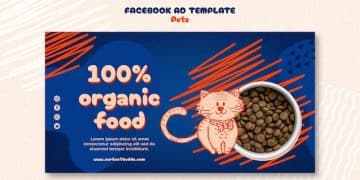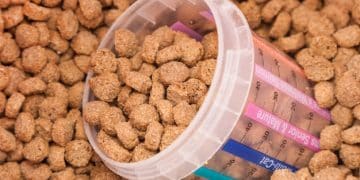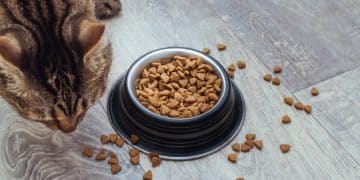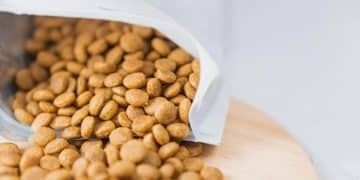Raw Food Diets for Pets: Unveiling the Truth, Benefits & Risks

Raw food diets for pets have gained popularity, promising improved health, but it’s crucial to weigh the documented benefits against potential risks like bacterial contamination and nutritional imbalances with expert veterinary oversight.
Considering a raw food diet for your furry friend? Discover the truth about raw food diets for pets: benefits, risks, and expert recommendations to make an informed decision about their health and well-being.
What is a Raw Food Diet for Pets?
A raw food diet for pets, often referred to as BARF (Biologically Appropriate Raw Food) or PMR (Prey Model Raw), typically consists of uncooked meats, bones, fruits, and vegetables. The intention is to mimic the natural diet of wild animals, believing it can lead to better health outcomes.
Proponents argue that raw food diets lead to shinier coats, healthier skin, improved digestion, and increased energy levels. However, it’s essential to carefully consider the science behind these claims and the potential downsides.
Key Components of a Raw Food Diet
Understanding what constitutes a raw food diet is the first step in evaluating its appropriateness for your pet.
- Raw Meat: Usually includes muscle meat, organ meat (like liver and kidney), and raw bones.
- Fruits and Vegetables: These can be added for fiber, vitamins, and minerals.
- Supplements: Some raw food diets may require supplements to ensure nutritional completeness.
Potential Benefits and Claims
Many pet owners are drawn to raw food diets due to anecdotal evidence and claims of various health benefits.
- Improved Digestion: Raw food is sometimes believed to be easier for pets to digest.
- Healthier Coat and Skin: Essential fatty acids in raw meats can contribute to a shinier coat.
- Increased Energy: Some owners report higher energy levels in their pets after switching to a raw diet.
While these benefits are enticing, they should be considered alongside scientific evidence and potential risks. Consulting with a veterinarian is crucial to determine if a raw food diet is right for your pet.
In conclusion, a raw food diet for pets aims to replicate the natural diet of wild animals, composed of uncooked meats, bones, fruits, and vegetables. While proponents claim benefits such as improved digestion and a healthier coat, it is vital to approach these claims with caution and seek expert veterinary advice.
The Benefits of Raw Food Diets for Pets: Separating Fact from Fiction
Raw food diets for pets are often touted for a range of health benefits, but it’s crucial to distinguish between anecdotal evidence and scientifically proven advantages. While some pets may thrive on raw food diets, others might not.
Before switching your pet to a raw food diet, it’s important to understand what the research says and consider the existing peer-reviewed articles.

Potential Benefits Supported by Anecdotal Evidence
Many pet owners report significant improvements in their pets’ health after switching to a raw food diet. These include:
- Improved Dental Health: Chewing on raw bones can help reduce plaque and tartar buildup.
- Reduced Allergies: Some owners claim that raw diets help alleviate food allergies.
- Weight Management: Raw diets can be lower in carbohydrates, potentially aiding in weight control.
Scientific Evidence: What the Research Says
While anecdotal evidence can be compelling, it’s crucial to consider scientific findings. Research on raw food diets for pets is ongoing, and the results are mixed.
- Nutrient Digestibility: Some studies suggest that pets may digest nutrients from raw food more efficiently.
- Gut Microbiome: Raw diets can alter the gut microbiome, but the long-term effects are still being studied.
- Immune Response: Some research indicates that raw food diets may enhance the immune system in some pets.
The scientific community emphasizes the need for more comprehensive studies to validate these claims and understand the potential risks involved.
In summary, while anecdotal evidence suggests several benefits of raw food diets for pets, such as improved dental health and reduced allergies, scientific research is still evolving. It is important to weigh these potential benefits against the known risks and to consult with a veterinarian before making any dietary changes.
The Risks of Raw Food Diets: What You Need to Know
While raw food diets have potential benefits, they also carry significant risks that pet owners need to be aware of. These risks range from bacterial contamination to nutritional imbalances, all of which can have serious health consequences for your pet.
Understanding these risks is essential for making an informed decision and taking the necessary precautions to protect your pet.
Bacterial Contamination and Food Safety
One of the most significant concerns associated with raw food diets is the risk of bacterial contamination. Raw meat can harbor harmful bacteria such as Salmonella, E. coli, and Listeria.
- Transmission to Pets: Pets consuming contaminated raw food can become ill.
- Transmission to Humans: Handling raw food can also expose humans to these bacteria, leading to foodborne illnesses.
- Environmental Contamination: Pets can shed bacteria in their feces, contaminating the environment.
Nutritional Imbalances and Deficiencies
Another critical risk of raw food diets is the potential for nutritional imbalances. Without careful planning and supplementation, pets can develop deficiencies in essential nutrients.
- Calcium and Phosphorus Imbalance: Inadequate bone content can lead to imbalances affecting bone health.
- Vitamin Deficiencies: Deficiencies in vitamins like vitamin D can cause serious health issues.
- Amino Acid Deficiencies: Inadequate protein sources or improper ratios can result in amino acid deficiencies.
These nutritional imbalances can lead to long-term health problems and may not be immediately apparent. Consulting with a veterinary nutritionist is crucial to ensure the diet is balanced.
Preventing Risks: Best Practices for Handling Raw Food
To minimize the risks associated with raw food diets, strict hygiene and preparation practices are necessary.
- Proper Handling: Always wash your hands thoroughly after handling raw meat.
- Safe Storage: Store raw food separately from other foods to prevent cross-contamination.
- Hygiene: Clean and disinfect all surfaces and utensils that come into contact with raw food.
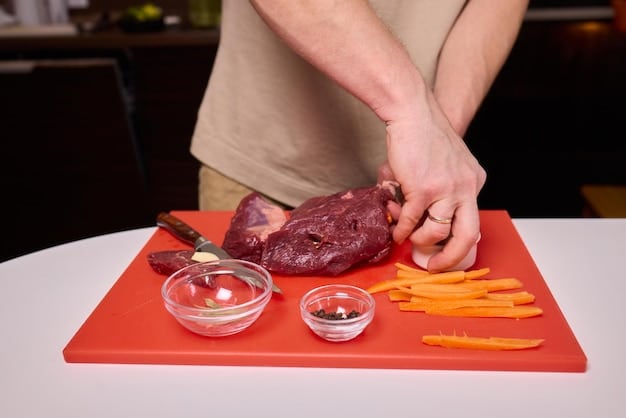
By taking these precautions, you can reduce the risk of bacterial contamination and ensure the safety of your pet and your family.
In conclusion, raw food diets for pets pose risks such as bacterial contamination and nutritional imbalances. Practicing stringent hygiene, consulting with veterinary nutritionists, and being aware of potential health consequences are vital steps for mitigating these risks and ensuring your pet’s well-being.
What Experts Say About Raw Food Diets for Pets
Veterinarians and animal nutritionists hold diverse opinions on raw food diets for pets. Understanding their perspectives is essential for making an informed decision about your pet’s diet.
Many experts emphasize the importance of consulting with a veterinarian or a board-certified veterinary nutritionist before switching your pet to a raw food diet. They can provide personalized recommendations based on your pet’s individual needs and health status.
Veterinarian Perspectives
Veterinarians often have mixed feelings about raw food diets, with some supporting them and others expressing concerns.
- Potential Benefits: Some veterinarians acknowledge the potential benefits of raw diets, such as improved digestion and coat health, when properly formulated.
- Risks and Concerns: Many veterinarians are concerned about the risk of bacterial contamination and nutritional imbalances.
- Importance of Formulation: Veterinarians stress the importance of working with a qualified nutritionist to ensure the diet is balanced and safe.
Animal Nutritionist Recommendations
Animal nutritionists specialize in formulating balanced and safe diets for pets. Their expertise is invaluable when considering a raw food diet.
- Thorough Evaluation: Nutritionists conduct thorough evaluations of your pet’s nutritional needs.
- Custom Formulation: They develop custom raw food diet plans that meet those needs.
- Ongoing Monitoring: Nutritionists provide ongoing monitoring and adjustments to the diet as needed.
Regulatory Standpoints
Regulatory bodies such as the FDA and the AVMA have issued statements about raw food diets for pets. They highlight the risks associated with these diets and recommend caution.
- FDA Recommendations: The FDA advises pet owners to thoroughly cook all pet food to kill harmful bacteria.
- AVMA Position: The AVMA discourages the feeding of raw food diets to pets due to the health risks.
Staying informed about these recommendations can help you make a responsible decision about your pet’s diet.
In brief, experts in veterinary science and animal nutrition have varying viewpoints on raw food diets for pets. Consulting with veterinarians and nutritionists, alongside considering regulatory advice, is vital for making well-informed choices about your pet’s dietary needs and health.
How to Safely Implement a Raw Food Diet for Your Pet
If you decide to proceed with a raw food diet for your pet, it’s essential to implement it safely. This involves careful planning, strict hygiene practices, and ongoing monitoring.
Always consult with a veterinarian or a board-certified veterinary nutritionist before making any dietary changes. They can provide guidance and support throughout the process.
Step-by-Step Implementation Guide
Follow these steps to safely transition your pet to a raw food diet:
- Consultation: Begin by consulting with a veterinarian or nutritionist.
- Assess Health: Ensure your pet is healthy enough for a diet change.
- Plan Diet: Create a balanced raw food diet plan with a professional.
- Gradual Transition: Slowly introduce raw food into their current diet.
- Monitor Progress: Watch for any adverse reactions during the transition.
Essential Precautions
Take these precautions to minimize the risks associated with raw food diets:
- Hygiene: Maintain strict hygiene standards when handling raw food.
- Temperature Control: Store raw food at proper temperatures to prevent bacterial growth.
- Separation: Keep raw food separate from other foods to avoid cross-contamination.
Monitoring Your Pet’s Health
Regularly monitor your pet’s health and behavior to ensure the raw food diet is beneficial.
- Weight: Monitor your pet’s weight to ensure they are maintaining a healthy body condition.
- Stool: Observe your pet’s stool for any signs of digestive upset.
- Energy Levels: Assess your pet’s energy levels and overall vitality.
If you notice any adverse reactions, such as vomiting or diarrhea, consult with your veterinarian immediately.
In summary, implementing a raw food diet safely for your pet involves careful planning, strict hygiene practices, and ongoing monitoring. Consulting with professionals, adhering to essential precautions, and closely monitoring your pet’s health are key to ensuring a smooth and beneficial transition.
Ingredients and What to Avoid in Raw Food Diets for Pets
Choosing the right ingredients is crucial for ensuring that a raw food diet is both nutritious and safe for your pet. Understanding what to include and what to avoid can help prevent nutritional imbalances and health issues.
A well-balanced raw food diet should include a variety of ingredients that provide essential nutrients. These include high-quality protein sources, healthy fats, vitamins, and minerals.
Recommended Ingredients
Focus on these ingredients to create a balanced raw food diet:
- Muscle Meat: Provides essential amino acids for muscle maintenance.
- Organ Meat: Liver, kidney, and other organs are rich in vitamins and minerals.
- Raw Bones: Provide calcium and phosphorus for bone health.
- Fruits and Vegetables: Offer fiber, vitamins, and antioxidants.
Ingredients to Avoid
Certain ingredients can be harmful to pets and should be avoided in raw food diets:
- Processed Foods: Avoid foods with artificial additives, preservatives, and fillers.
- Toxic Foods: Never include onions, garlic, grapes, raisins, or chocolate, as these are toxic to pets.
- Cooked Bones: Cooked bones can splinter and cause internal injuries.
Ensuring Nutritional Balance
To ensure nutritional balance, consider these factors:
- Protein Sources: Use a variety of protein sources to provide a complete amino acid profile.
- Fat Sources: Include healthy fats such as fish oil for omega-3 fatty acids.
- Supplements: Add supplements as needed to address any potential deficiencies.
Consulting with a veterinary nutritionist can help you formulate a diet that meets your pet’s specific needs.
In short, preparing a healthy raw food diet for pets requires careful selection of ingredients, including muscle meat, organ meat, raw bones, and appropriate fruits and vegetables. Avoiding processed and toxic foods, alongside ensuring nutritional balance, is vital for your pet’s health and well-being.
| Key Point | Brief Description |
|---|---|
| 🥩 Raw Diet Basics | Uncooked meats, bones, fruits, and vegetables replicating wild diets. |
| ⚠️ Key Risks | Bacterial contamination and potential for imbalanced nutrition. |
| ✅ Safe Implementation | Consult vets, ensure hygiene, and monitor your pet’s health regularly. |
| 🩺 Expert Advice | Vets emphasize the need to balance diet and minimize contamination risks. |
Not necessarily. Nutritional value depends on the quality and balance of ingredients. Commercial pet foods are often formulated to meet specific nutritional standards, while raw diets require careful planning to avoid deficiencies. No, raw food diets are not a cure-all. While some pets may experience improvements in certain health conditions, it is essential to consult with a veterinarian for appropriate medical treatment and dietary advice. It can be risky. Grocery store meat intended for human consumption may still contain harmful bacteria. Sourcing raw meat from reputable suppliers who test for pathogens is a safer option. No, certain pets, especially those with compromised immune systems or specific health conditions, may not be suitable for raw food diets. Puppies and senior pets also require careful consideration and close veterinary supervision. Consult with a board-certified veterinary nutritionist. They can help you formulate a diet that meets your pet’s nutritional needs, ensuring the proper balance of protein, fat, vitamins, and minerals to avoid deficiencies. In conclusion, while raw food diets for pets hold promise with potential benefits, they also present significant risks that require careful consideration and proper risk mitigation. Informed decision-making—guided by expert veterinary and nutritional advice, coupled with meticulous hygiene practices—is of utmost importance in ensuring your pet’s health and longevity.
▼
▼
▼
▼
▼Conclusion

